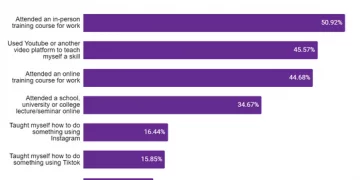
Five Challenges to Virtual Team Success
Running a virtual team is one of the modern challenges many managers face. Managing your workers remotely can be difficult.
This article looks at five challenges to virtual team success that you may encounter along the way.
Being successful in managing this new team type is a key skill and covered in our line manager courses
Background
The Office for National Statistics revealed that the number of people working from home almost doubled from 2019 to 2020.
This has led to an entirely new lifestyle for millions of people. It has also caused companies to re-think their traditional way of carrying out their processes.
Not every type of industry or role is ideally suited to remote working.
For some businesses, the switch to working from home is relatively easy. For others, putting the right processes in place can be a serious challenge.
We also need to remember that people have different lifestyles and needs. The introverts in your team may be delighted to spend more time at home with their young family or pets.
However, other members of your team may find that remote working makes them nervous, stressed, or depressed.
Awareness is the first step to fixing a problem. Knowing this, we can now look at the top five challenges to virtual team success and how to overcome them.
Need more of a starting guide to line manager positions? Read our guide on exactly what a line manager is here.
The Top Five Challenges to Virtual Team Success
1. Communication
If your team is scattered across the country or the world, getting the same message across to everyone can be the biggest of your virtual team problems.
This is even harder if time differences and language barriers stand in the way.
Even if you hold regular video meetings, your message may not get across clearly. Some people may also be reluctant to speak up about their doubts and difficulties working in a virtual team.
2. Working Relationships
Good working relationships are vital to any team pulling together and producing excellent performances.
Naturally, it is far more difficult for team members to feel a strong connection when they don’t work in the same location. Perhaps they have never even met personally.
This makes virtual team building even more important, than team building in the physical world.
Gallup research has shown over 30% of people have a best friend at work. This boosts their engagement levels by over 700% compared to those who don’t work alongside their friends.
A large part of this is to help build trust between your remote team members that will allow them to collaborate more closely.
3. Loss of Focus / Productivity
There’s a lot of talk on whether working from home increases or reduces productivity. Each person is likely to have a unique experience when working remotely.
A Work After Lockdown survey found that 54% of the Brits surveyed had improved their productivity after shifting to a home office. Fewer than 10% felt their productivity suffered.
Yet, the fact that this was a relatively new change for them when they were surveyed raises the question of whether they may lose focus over time.
4. Security Issues
Cybersecurity has been a hot subject long before the pandemic. This is due to workers beginning to use mobile devices to get connected in their offices. The rise in remote working has now turned cybersecurity into a critical issue.
If you have people handling sensitive data and hooking up to your system from different places, it can create gaps in your security.
Research by Apricorn suggests that 35% of UK companies believe remote workers have put their data at risk. In addition, 58% of them think that their remote employees might expose them to a potential data breach.
These figures confirm cybersecurity as one of the key challenges of a virtual team.
5. Lack of Motivation or Low Morale
Some people are delighted to get the opportunity to work from home, as it gives them a chance to try out a new lifestyle that might suit them perfectly. For others, a lack of motivation can lead to a drop in productivity.
Remote work can even lead to depression or other mental health issues.
A poor work-life balance is mostly to blame for this, as well as changing one’s sleeping, diet, and working habits. Working from home is disruptive, and not all workers embrace such a dramatic change in their routines.
5 Solutions for Virtual Team Success
Thankfully, all the problems we’ve identified are fixable. These are things that you can do pretty easily to get everyone working together seamlessly again:
1. Regular Communication and a Clear Vision
Having at least one weekly meeting that everyone has to attend will allow your whole team to stay updated with what is happening. This could be the right time to brush up on your communication and presentation skills.
It also makes sense to have a clear communication strategy and vision in place. This means that people don’t have to guess when to call a virtual meeting, send an email, or share documents.
Use messaging tools like Slack and Telegram, and try adding a whiteboard to your meetings, so that you can take notes easily. Making use of tools can help fix communication issues.
If you would like to improve your presentation skills as a manager, don’t miss our article on this topic.
2. Encourage Bonding Sessions
With a little creativity, you can still organise team-building sessions for your virtual team.
If your team members live close enough to one another, organise an in-person get together. Done once per month, this wouldn’t be a big time commitment, but can make a big difference to how well they know each other and how much they trust other virtual team members.
When planning your virtual team-building session, move away from the old-fashioned ice-breakers and team games. Instead, try virtual experiences and online training sessions that your team will truly benefit from.
3. Put the Focus on Productivity
The use of online productivity and collaboration tools can allow any remote team to work more efficiently. Google Workspace lets you all work together using a cloud-based service in which you can share, edit and collaborate effortlessly at any time.
Other collaboration tools worth considering include:
-
- Asana
- Trello
- Podio
- Monday.com
- Ryver
- Flock
Whatever tasks you need to manage, you are almost certain to find a tool that lets you do it online now. Don’t stick to old, stiff processes that no longer fit your team’s requirements. Put a strong emphasis on good time management and efficiency.
4. Security
Many of the best cybersecurity tips apply just as well to remote workers as they do to people working in the office. The use of strong passwords and antivirus software that’s regularly updated is crucial to a safe online work environment.
Perhaps the most significant difference for home workers is that they need to be reminded regularly to do things that your IT team would do for them if they worked in the same building.
5. Find Ways to Motivate Everyone
Finding how to keep a remote team highly motivated may pose the highest challenge of managing a virtual team. Uniting your team’s efforts towards one clear goal is one way to inspire and motivate.
Aside from creating a supportive work culture, you should ensure that you ask for and provide regular feedback. Feedback is valuable, especially coming from those team members who might be overwhelmed by remote work.
Online training sessions for remote team managers will also let you discover how to best motivate your team.
Conclusion
The shift towards remote teams has been one of the most significant and sudden changes in the history of the business world.
The good news is that there is now a wealth of ideas and tools that you can use to overcome the top five challenges to virtual team success.
If you would like more on this subject, see our article.
For more time management tips, read our guide to setting smart goals here.


